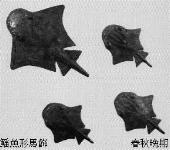 |
The four flounder-shaped objects were just ornaments
for a horse' headgear from the Spring and Autumn period 春秋. |
 |
A warrior of bronze. His eagle beak shaped tinhat is
a proof of the non-Chinese origin of this object from the
Warring States period 戰國. It is indeed a relict of the Saka
culture of Xinjiang. |
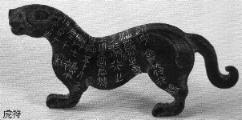 |
This kind of tiger-shaped object
called hufu 虎符 "tiger
symbol" served from the Warring States period on as
a document of the owner' enfeoffment or official
authority. In old times, bamboo was used for a
documentation and then broken or cut in two pieces. One
half stayed in the palace's archives, the other was
handed to the new baron or general. |
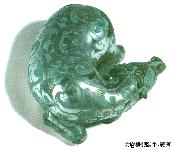 |
From the Warring States period on, the art to inlay
gold and silver made a great improvement. This sleeping
calf or cow has a bronze core and is decorated with
silver ornaments. |
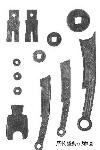 |
The coin shape we know today is
the round one with the quadrangular hole in the middle.
Buildings and art objects with this shape symbolize earth
(quadranguar, the feet) and the heaven (round, the head).
Even the word for "round", yuan 圓, is still today similar to the word
for "coin" in Chinese (Yuan, abbreviated to 元), Japanese (Yen)
and Korean (Wŏn). The two other kinds of coins during the
Warring States period were a knife-shaped coin (dao
刀), a type shaped like a cowry
shell (bei 貝) and a
spade-shaped one (bu 布). See more on the money page. |
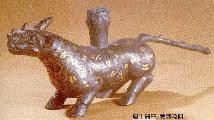 |
Being the stand for a screen or a candle, this
fabulous animal is a mixture of a rhino and a tiger. It
is inlaid with gold and silver. |
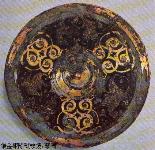 |
Inlaid with gold and silver and showing fighting
animals, this backside of a bronze mirror is a wonderful
work of the late Warring States period. |
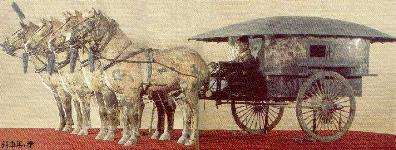 Only 104 cm tall, this bronze coach from the Qin Dynasty 秦 is a perfection of early goldsmithry. The main part of
the chariot, the horses and the driver are cast of bronze
and painted with different colors and worked with
many different technics like soldering, inlaying,
embossing, chiseling and filing. Only 104 cm tall, this bronze coach from the Qin Dynasty 秦 is a perfection of early goldsmithry. The main part of
the chariot, the horses and the driver are cast of bronze
and painted with different colors and worked with
many different technics like soldering, inlaying,
embossing, chiseling and filing. |
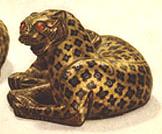 |
Inlaid with gold and with red stones, two leopards
from the Han Dynasty 漢. |
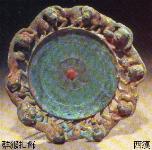 |
This belt buckle from the Han dynasty is inlaid with
turquois stones. The border has the shape of a herd of
monkeys. |
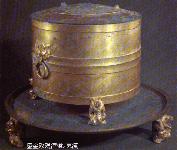 |
A storing vessel, standing on a small round platform.
This type of vessel called zun 樽
was only in use during Han times, and it is not shure if
its only purpose was to contain wine. No dragons or
Taotie ornament the surface of the golden box. |
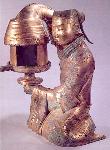 |
Designing human faces is a new expression of Han
Dynasty art. Faces and movements became more real then in
older times. Man is now the center of art, not the
gods and ancestors or fabulous animals. This 84 cm tall wonderful tool of the
Changxin Palace 長信宮 shows a girl holding a lamp or a sublimation tool for alchemist material. |
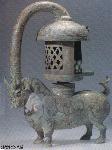 |
An other wonderul piece of Han Dynasty's lamps has
the shape of a bull, inlaid with silver. From the bull's
head to the top of the lamp, a handle stretches (46 cm
tall). The surface is very smooth. In spite of his
weighty body, the piggy tail of the bull make him a bit
funny. |
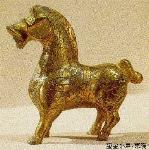 |
A small embossed horse from the Han Dynasty. |
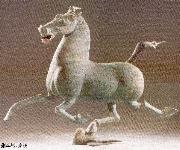 |
Cast of bronze, this amazing and very famous artwork shows a
galopping horse balancing on a swallow. |
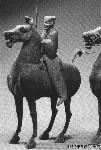 |
Only one piece of a whole cavalry company is this
bronze cast warrior of the Han Dynasty. |
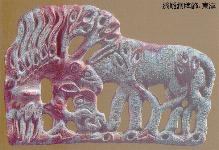 |
This ornament (a belt buckle or a brooch) of the Han Dynasty shows an unidentifiable animal
with its head in the bushes. Parts of the object are
already stained. |
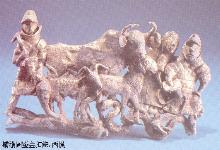 |
A belt buckle with the shape of shepherds and a cow
from the Han Dynasty. Goldened bronze, 15 cm long. |
 |
An incense burner from the Han Dynasty. It has the
shape of mythical mountain, inlaid with gold and silver
stripes in the shape of dragons and decorated with many
people and beasts (28 cm tall). |
 |
This Pusa 菩薩 (Bodhisattva) is one of the
first Buddhist art objects found in China. It was made in
the Eastern Jin period 東晉. |
  |
When Buddhism was introduced into China, it was first
the upper class of the former-nomadic Northern Dynasties 北朝
that adopted the foreign religion. During the Northern
Wei dynasty, these very handy Buddha images became very
popular to put them on a family or house altar. |
 |
This image from the short-lived Sui Dynasty 隋 shows a
whole group like they were carved in the grottoes of
Yungang 雲崗 and Longmen 龍門. The center is the sitting Buddha,
to his left and his right two disciples. In front of them
are two guardians. The whole gold-covered group is
standing on a table whose feet have the shape of fierce
animals. |
 |
During the Tang Dynasty 唐, fat people were the ideal
body type (just like in Europe during the 17th century).
Accordingly, this Guanyin 觀音
image also gives her fat cheeks. Looking at the wall
paintings in Dunhuang 敦煌, we
see that also the floating bands around the body were
very popular during the Tang Dynasty. |
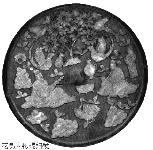 |
Inlaid with mother-of-pearl, this Tang time mirror
back side shows people sitting in a garden, playing lute
and drinking wine. |
 |
This hairpin from the Five Dynasties 五代 has the shape of
a butterfly with jade wings and very light, almost
floating and always moving pendants. |
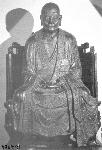 |
One of the famous men going to India to take the
sutras to China and to translate them later into Chinese
was the patriarch Huineng 慧能. This
Northern Song 北宋 time bronze statue shows him in a
meditating position. |
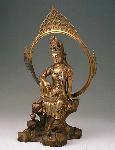 |
This big gloriole around the Pusa-Bodhisattva's head
from the Northern Song Dynasty shows Indian and Tibetian
influence. |
 |
The Liao Dynasty 遼 was founded by the nomadic Khitan
people. They quickly adopted Chinese culture and religion.
A meditating Guanyin image shows how exactly they copied
Chinese style art objects. |
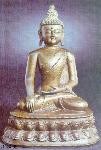 |
Especially during the Yuan time 元, when the Mongols
governed China, their trust in Lamaism is reflected in
the shape of the Buddha images. They become more crude
like the left example or more overloaded with
accompanying glorioles and auras. |
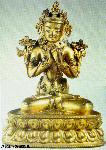 |
A Tibetian style Manjusri from the Yuan time. |
 |
Ming time 明 Guanyin statuettes are mostly standing. The
Guanyin is a female personification of the Avalokitesvara
Bodhisattva and thus not only a person meditating and
contemplating, but also giving protection and help to the
true believer. |
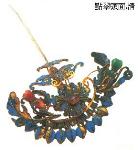 |
With the shape of flowers and butterflies, this Qing
time 清 hairpin is covered with enamel, giving it different
colors, mostly blue, a favorite color of emaille
technique. |
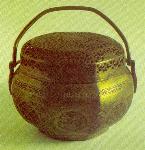 |
An incense burner or hand warmer from the imperial palace in Peking.
The cover is dotted with many holes to let out the
incense odor. |
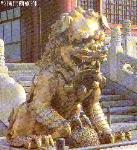 |
As a guard of the imperial palace, two lions flank
the entrance of the Hall of the Highest Peace in Beijing.
They look more like a kind of dog. The female lion is
accompanied by its kid, the male one plays with a ball. |
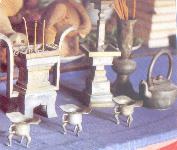 |
Until the whole time of the Chinese Empire, the main
task for the emperor, more even than to govern, was to
worship his ancestors, the heaven and the earth. For this
reason, ritual vessels had great importance until the end
of the empire in 1911. |
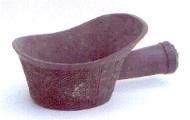 |
Containing hot charcoal, the objective of this "bowl" was to
serve as an ironing tool. It is not clear why the ironing area of this iron from Anhui is
this small. |
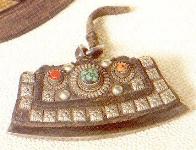 |
Nomadic people lay great stress on the beauty of
daily used articles like the Mongolian lighters on the
left, ornamented with silver and inlaid with different
stones. |
 |
The Mongols adopted the Lamaist Buddhism from Tibet
and established many Lamaist temples in their capital in
Peking. Thus, a great part of their art object also shows
Lamaist influence like this Qing time Tantra figure with
a divine couple in embracement. |
 |
This object is a water pipe from the late Qing time in Jiangsu province. |